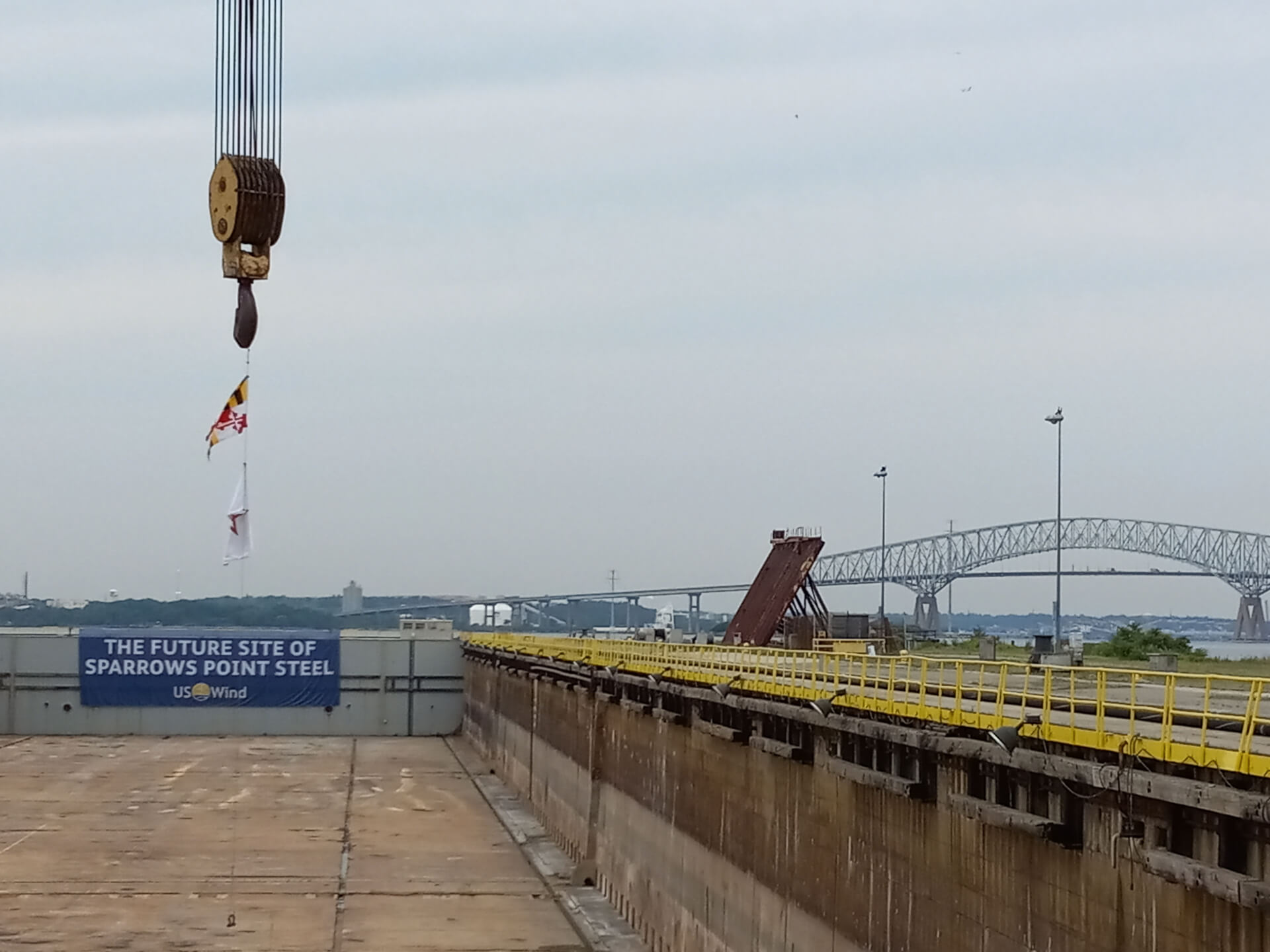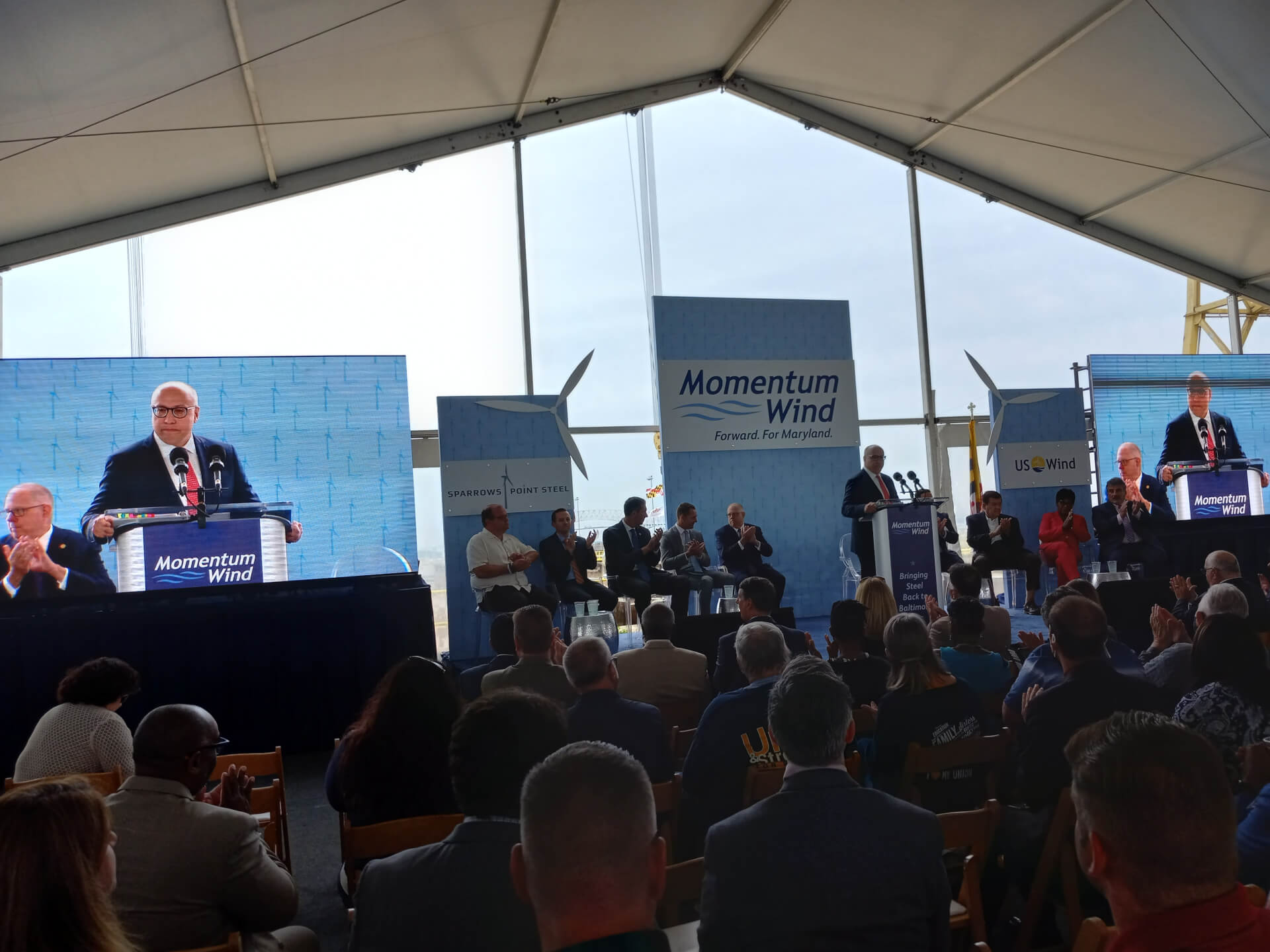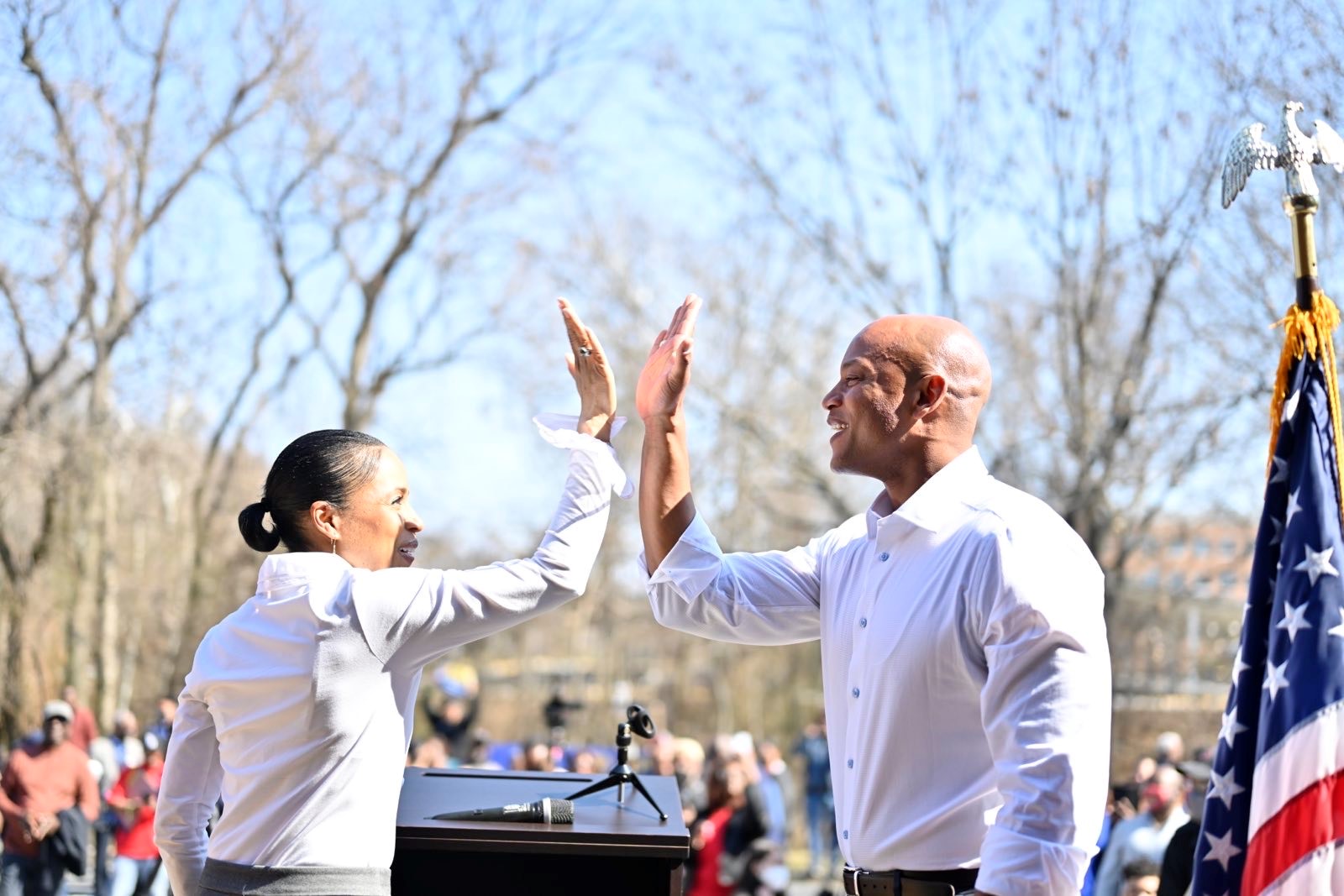At Offshore Wind Announcement, New Hope for Steel Industry, but Climate Change Gets Short Shrift

The topline news carried a political, economic and cultural wallop: State, federal and local officials, along with corporate chieftains and union heavyweights, announced Tuesday that steelmaking would return to the iconic Sparrows Point industrial complex in eastern Baltimore County, as a prominent wind energy developer looks to expand its operations in Maryland.
But the announcement, bathed in a celebratory air near the hulking remains of the old Bethlehem Steel plant, comes with many questions — some of which probably won’t be answered for years. And while the development is a huge boost for the fledgling offshore wind energy industry in the U.S., the words “climate change” were barely uttered by the long line of speakers.
The four-pronged announcement centered around the plans of US Wind, Inc., one of two companies state regulators have selected to build wind energy turbines off the coast of Ocean City. US Wind CEO Jeff Grybowski told hundreds of dignitaries who assembled Tuesday that the company:
- Hopes to expand significantly its offshore wind presence in federal waters off Maryland with a new project called Momentum Wind to complement its ongoing MarWin development;
- Has reached major labor agreements with the Baltimore-D.C. Building & Construction trades union and the International Brotherhood of Electrical Workers to provide union labor for ongoing work on the first phase of the offshore wind development;
- Has signed an agreement with Tradepoint Atlantic, the company that has taken over management of the Sparrows Point development, to invest $77 million in a new 90-acre port facility to service offshore wind development in Maryland;
- Wants to build a new steel fabrication facility at Tradepoint Atlantic, which would eventually hire 500 welders, painters, crane operators and equipment operators — with the blessings of the powerful United Steelworkers union.
Grybowski and many other speakers called the announcement “transformational” — for the Tradepoint Atlantic development, for the Baltimore-area economy, for Maryland’s potential as a clean energy leader, and for the overall U.S. offshore wind industry.
“We’ve been waiting for a long time for some good news, and here it is,” said U.S. Rep. C.A. Dutch Ruppersberger (D-Md.), a former Baltimore County executive whose district includes Sparrows Point.
The potential economic impact of the developments is stunning. According to US Wind, just the second phase of the offshore wind project could produce 3,500 direct construction jobs, over $300 million in construction labor income, 100 direct operations jobs, and over $500 million in operations labor income over 25 years.
Several of the leaders who spoke harkened back to the old Bethlehem Steel plant’s history as a key supplier for the American military during two world wars and for public works landmarks like the Golden Gate Bridge.

U.S. Wind CEO Jeff Grybowski addresses the crowd at Sparrows Point on Tuesday. Gov. Lawrence J. Hogan Jr. (R) is to his left. Photo by Josh Kurtz.
“We are at a historic location — the former home of U.S. Steel,” Grybowski said. “The shipyard. One of the most important industrial sites in the history of the U.S.”
Kerry Doyle, managing director of Tradepoint Atlantic, called the announcement “a full-circle moment.”
Jim Strong, assistant director of the United Steelworkers, offered perhaps the most poignant remarks.
“Prior to this announcement, the only thing steelworkers had was memories,” he said. “…We know now that there’s a future. We know it’s just a matter of time before steelworkers return home. And it’ll be here at Sparrows Point.”
But despite the multiple agreements signed, commitments made and vows of support by powerful leaders, it could be years before the projects fully come together — and most haven’t even gone through the earliest stages of government approval.
Even US Wind’s MarWin project, approximately 17 miles from the Ocean City beach — which would build up to 22 wind turbines generating enough energy to power 80,000 homes — still awaits final approval from the U.S. Department of Interior’s Bureau of Offshore Energy Management (BOEM). The company also still needs approval from the Maryland Public Service Commission (PSC) to build taller windmill towers than it originally proposed — a process that Ocean City leaders hope will prompt the PSC to push the windmills farther offshore. And US Wind has yet to figure out where to land the electric cables it would run onshore from the wind turbines out at sea.
US Wind currently estimates that this first segment of the wind development will be up and running by 2025.
The next phase — Momentum Wind — envisions 82 turbines in the ocean, just west of the MarWin project, enough to power 400,000 homes. That proposal requires PSC approval as well as a sign-off from the federal government — a process that could take years.
Last month, Ørsted, the Danish offshore wind developer that also has secured state approval for the first phase of a wind farm in the ocean and awaits a final green light from BOEM, announced that it had submitted a bid to the PSC for a second offshore wind project. Ørsted officials are aiming to have the first phase of the wind development up and running by 2026.
Even the agreement to build a new steel plant at Sparrows Point — a dream of local leaders that has taken on almost-mythical proportions over the years — is probably years from fruition and will require approval from federal, state and local regulators.
Still, the second phases of the US Wind and Ørsted developments, if they are approved, would help burnish Maryland’s reputation as a place where clean energy projects can flourish, as would a manufacturing hub for wind energy at Tradepoint Atlantic. Right now, Maryland is behind certain other Northeastern states when it comes to development of offshore wind, but these projects can help close the gap.
“Offshore wind presents a once-in-a-generation opportunity for the state of Maryland to expand and diversify our economy and our energy portfolio,” Gov. Lawrence J. Hogan Jr. (R) said at the ceremony Tuesday. “For six and a half years now, our state has been leading the charge when it comes to supporting responsible and clean energy projects, and we are proud to continue setting an example for the nation of strong environmental leadership.”
˃ ˃ RELATED: Winds of Change: Source of Power and Struggle
Legislative permission to bring offshore wind projects to Maryland came in 2013, when Hogan’s predecessor, former Gov. Martin J. O’Malley (D), was in office. And the Democratic-led General Assembly passed legislation in 2019 to expand clean energy mandates in the state — a bill that Hogan criticized but allowed to become law without his signature.
So it was perhaps fitting that the only mentions of the climate crisis during Tuesday’s public presentation came from the presiding officers of the legislature, Senate President Bill Ferguson (D-Baltimore City) and House Speaker Adrienne A. Jones (D-Baltimore County).
“These projects are further indication that we can take aggressive action to reverse climate change while stimulating the state’s workforce and economy,” Jones said.
Some environmentalists — many of whom attended the event but were not invited to speak — were privately irked that climate change got short shrift in the narrative. But they seemed generally happy with the substance of the announcement.
Gesturing to the massive tent-like structure that was erected to house all the dignitaries, and then to the cross-section of political, business, civic and environmental leaders present, Jamie DeMarco, the federal and Maryland policy director for the Chesapeake Climate Action Network observed, “Offshore wind is the big tent.”





 Creative Commons Attribution
Creative Commons Attribution